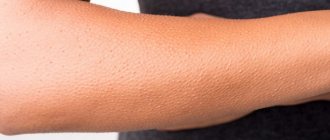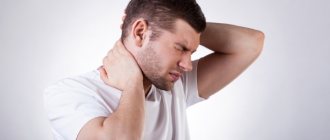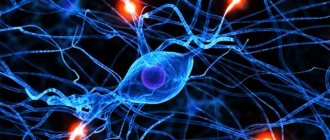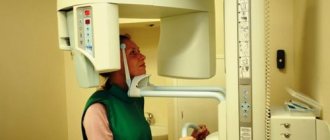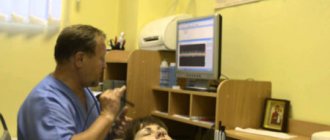The largest group of patients (about 75%) who have pain on the right side of the head have primary cephalalgia. It occurs on its own; no other disease is involved in its etiology. The most well-known disease is migraine, but the most common is tension headache (arising from excessive mental stress).
Temporal arteritis
Temporal arteritis is an autoimmune disorder that is associated with inflammation of a medium- to large-sized artery. Typically, temporal arteritis is observed in patients over 50 years of age. This disease manifests itself in the form of severe headaches, redness of the scalp, as well as attacks of depression and insomnia. Therefore, if your head hurts on the left side or on the right, perhaps we are talking about this particular disease. You should not ignore these symptoms; it is better to seek help from a doctor. If this is not done, the patient may completely lose vision.
What to do if a tooth is suffering from a headache
If the cause of a headache that radiates to the tooth is neuralgia, go to a neurologist. Do not self-medicate and do not rush to remove a tooth, because if the cause of unpleasant manifestations is not in the teeth, it will not disappear with their removal.
If toothaches are a consequence of sinusitis, you need to fight the root cause of the infection in the maxillary sinuses. You can reduce discomfort in your teeth with the help of local analgesics and traditional herbal remedies:
The first include Analgin, Aspirin, Tempalgin, Ibuprofen and Paracetamol in powder forms or in the form of highly crushed tablets. These products are used when the temperature rises significantly.
In case of exacerbation of pain, lotions based on saline solutions should be applied. Natural remedies to combat toothache due to sinusitis include sage (extracts and tinctures), mint, lemon balm, and garlic. For cluster headaches, an oxygen mask is used; for exacerbations, nasal drops based on lidocaine or somatostanin are prescribed.
Intracranial bleeding
We continue to consider why the head hurts on the left or right. The reason for this may be intracranial bleeding. If there is damage to the vessels that supply the brain, an intracranial hematoma can form. A hematoma is caused by head injuries as a result of a blow or accident. The spread of bruising is also a cause of increased intracranial pressure. This is why the patient develops a shooting headache, which is accompanied by a slow heartbeat, general lethargy, confusion, as well as seizures and vomiting. You should not ignore the symptom of a headache on the left or right. Such bleeding can lead to very disastrous consequences, even death. If the pain does not go away after several days after the blow, you should definitely consult a doctor.
The main conditions for the manifestation of pain in the right temple
Pain in the right temple of the head appears both for completely natural and easily explainable reasons, and as a result of certain diseases. Let's consider each group of reasons separately.
The most common external factors that cause headaches in the right temple are:
- the pillow is of the wrong height and shape, the mattress is too soft;
- prolonged sleep, especially if the person fell asleep in an uncomfortable position;
- lack of oxygen associated with lack of good ventilation at home and workplace, rare walks in the fresh air;
- changes in atmospheric pressure, for example, during air travel or climbing a mountain;
- addiction to smoking or consuming alcohol-containing products;
- frequent visual stress - sitting for a long time in front of a monitor, TV, working with text documents;
- malnutrition, diets, dry fasting;
- poisoning by poor-quality food, medicines, mushrooms;
- intense motor, mental and psycho-emotional stress.
Cluster pain
Paroxysmal unilateral sensations that appear in the front area of the head, near the eyes, occur in most cases in men. If the head and eye hurt on one side, then often such a shooting and bursting syndrome turns out to be so strong that a person simply cannot carry out normal life activities. In addition, the patient suffers from other symptoms:
- runny nose;
- tearfulness;
- tides;
- redness of the eyes.
The main symptom of cluster pain is its frequency. As a rule, they appear at the same time of day. The duration of attacks can range from several minutes to an hour and a half. In this case, you should pay attention to the fact that the interval between attacks will always be the same. If the eye and head hurt on one side due to cluster pain, then this symptom may disappear as suddenly as it appeared. It is impossible to relieve pain with conventional painkillers. As a rule, this requires the medications prescribed by the doctor. In some cases, oxygen treatment is prescribed for therapy.
Exercise No. 3. for lips
A visit to the dental office is necessary to examine the oral cavity and exclude dental diseases, carious damage, pulpitis, and periodontitis. An x-ray is often prescribed if the examination does not provide clear indications. In this case, diseases of the bone tissue in the mouth are treated by a maxillofacial surgeon. who also practices dental treatment.
The therapist has the right to prescribe a complete examination of the person’s body. Any inflammation is often reflected in blood counts. Magnetic resonance imaging may also be recommended. In cases with neuralgia, examination is carried out using computed tomography. Back to top
Neuritis of the facial nerve can be treated with means for both external and internal use. As a rule, folk remedies for the treatment of a cold nerve are prepared on the basis of medicinal herbs, bee products and - sometimes - alcohol-containing preparations.
- Tooth hurts, radiates into the ear: what are the reasons?
- Eye tooth pain symptoms
Migraine
If we translate this term from ancient Greek, it translates as “half of the head.” This is due to the fact that the pathological condition is characterized by the occurrence of shooting unilateral pains, which over time become throbbing. Very often, with a migraine, the head hurts when touched on one side.
The frequency of the attack may vary, although it occurs no more than 8 times in one month. The duration of such an attack can range from several hours to several days. In addition to the fact that with a migraine the head hurts on one side, the pressure also drops, the person feels photophobia and nausea. In some situations, such attacks are accompanied by an aura, which causes blurred vision, problems with concentration, and auditory and visual hallucinations.
It is believed that those people who most often suffer from migraines are those who have a genetic predisposition to this disease. It should be noted that there is no drug that can permanently eliminate migraine headaches. Antimigraine therapy, used recently, can reduce the duration and frequency of painful attacks.
Pain on the right: specifying the location
If the right side of your head hurts, you should listen to your own feelings more carefully. By clearly identifying the painful area, you can independently find out the cause of cephalgia. At the same time, you should not delay visiting a doctor, especially if the attacks are intense, sudden, permanent, or repeated more than 5 times a month.
In addition to such obvious reasons as injury or hangover, a throbbing headache covering the forehead on the right can be triggered by a migraine or cluster syndrome. With pathology of the cerebral vessels of the frontal lobe, optic neuralgia, painful sensations take the form of sharp, sudden impulses.
If the pulsation is constant and the pain is aching, one can assume inflammation of the maxillary or frontal sinus (sinusitis, frontal sinusitis), as well as influenza or other viral infection.
Back of the head
Pain in the occipital region often occurs due to high blood pressure or injury. However, if it is localized precisely on the right side, inflammation of one of the paired nerves in the back of the head, the right one, is most likely to occur.
Tumors
Neoplasms that are localized in the brain can cause an increase in intracranial pressure, as well as the subsequent spread of a painful syndrome that is shooting, dull or bursting in nature. In addition to the fact that with an existing tumor there is a headache in one point on the left or right, other symptoms also appear, which include the following:
- attacks of vomiting and dizziness;
- changes occurring in the psycho-emotional sphere;
- sudden and significant weight loss;
- epileptic seizure.
You should also pay attention to the fact that the patient’s condition begins to deteriorate in case of severe nervous shock or stress.
Diseases that cause facial pain.
A facial migraine lasts a very long time, it is accompanied by sharp and aching pain in the facial area, or pressure on the eyeballs, it can develop into a migraine headache, it is accompanied by a decline in mood and mental anxiety (in some cases for a day), sometimes accompanied by nausea, vomiting, the pain is localized in Most in the vessels, not in the nerves.
And these are not all the circumstances under which you risk catching a cold. Any other hypothermia entails a decrease in the immune system and protective function of the body.
Costen's syndrome
This disease can be associated with rheumatism, trauma to the temporomandibular joint, gout, as well as the presence of certain infectious pathologies. With this syndrome, the ear and head hurt on one side. In addition, there is a burning sensation on the tongue, as well as dryness in the mouth. An accurate diagnosis can only be made using x-rays.
Tension pain
This pathological condition is otherwise called tension headaches. This disease is characterized by moderate severity of pain, which covers one side of the head and lies in the central region of the forehead. Tension pain, which intensifies in the evening, can be squeezing or dull. Associated symptoms of the disease are as follows:
- the appearance of problems with sleep;
- pronounced sensitivity to various sound devices;
- general fatigue.
Statistics show that the disease becomes chronic in only 3% of registered cases. As a rule, it is not possible to find out what exactly triggered the development of this disease.
How to determine that toothaches are caused by a headache and not by oral diseases
Localization of sensations: if all the teeth of the upper, lower jaw, right or left are in severe pain for a long time, if not one specific tooth is suffering, but a whole group of teeth, then most likely the dentist will not help you.
The relationship between sensations in the teeth and in the head: if, when the unpleasant sensations in the head weaken, they disappear in the jaw, then you probably have a cluster headache radiating to the tooth.
Absence of dental problems: if the x-ray of the jaw does not show any problems, feel free to go to a neurologist, even if the discomfort in the teeth is very strong and it seems that they are the ones that hurt.
Traumatic brain injuries
If the patient has scalp pain on one side and also a headache, then perhaps the cause lies in a traumatic brain injury. As a rule, this kind of damage is accompanied by severe pain on the side where the blow was struck. It should be noted that the presence of injury itself can be determined much later. Therefore, if the scalp hurts on one side, and other symptoms appear, you should seek help from a doctor. Other noticeable signs of a traumatic brain injury include:
- general weakness;
- nausea and vomiting;
- tinnitus;
- dizziness.
Symptoms will become more pronounced when the victim makes sudden movements.
Causes
There are more than 40 causes of pain on the right side of the head. Many of them are not dangerous, but there are some that can be fatal without timely treatment. Headaches most often affect women, and the most common cause is migraine.
Troubles of this nature disturb a person when he is exposed to a draft, sometimes due to dental diseases. Occurs in the right hemisphere of the head due to the development of neurological disorders or diseases. For example, cervical osteochondrosis causes pain only on the right side of the head.
Migraine
The very meaning of the word “Migraine”, if we turn to its original meaning, meant “half of the head.” The disease is chronic and neurological in nature. People experience pain that is localized to one side of the head, but not over its entire surface. Very rarely, a migraine causes discomfort over the entire surface. Attacks may occur with varying frequency. Sometimes they make themselves felt several times a day, in some cases a couple of times a year. Most often, patients experience about 1 attack every 4 days.
A migraine can last from a few hours to 3 days. Patients describe it as pulsating in the temporal lobes. Nausea, vomiting, and aversion to light appear. It seems that the brain “starts to shoot.” If migraine with aura, a neurological disorder appears before the attack. It manifests itself in visual hallucinations, blurred vision, and severe weakness. After some time, a headache begins on the right side of the head.
Research shows that migraines are passed on through genes. It is widely believed that the disease is common only in females, but now it is actively developing in males as well.
An effective way to combat migraines has not yet been invented, and about 70% of people remain dissatisfied with the results of the therapy. Analgesics, anticonvulsants, and antidepressants are used for treatment.
Cervical osteochondrosis
This disease affects the intervertebral discs and neck areas. People over 35 years of age who move little and eat poorly are susceptible to illness. Headache is one of the symptoms. When turning the eyeballs, it intensifies, and medications do little to relieve it. The left side of the head may also hurt.
In this case, massage or warming ointments, the effect of which should be directed to the neck, can help. If your head hurts badly, taking a horizontal position will help. You should be especially careful when treating the disease if the discomfort is localized on the right side.
Cluster headache
The main feature of such ailments is repetition according to cluster classification. Intervals may vary in length. As an example, a headache may appear, pressing in the temporal lobes every day for 20 days and repeating once a year. Painful sensations here will only be one-sided, that is, concentrated on the right or left side and very pronounced. Sometimes a posterior source of discomfort appears.
Doctors cannot say exactly why cluster headaches appear, but they cannot relieve them with medications. Scientists have proven that even a minimal dose of alcohol can trigger an attack.
If there is a suspicion of cluster pain, drinking alcohol during periods when it appears is not recommended at all.
Tumor
There are more than 100 types of brain tumors. They appear with different strengths, depending on the size of the damage. Sometimes pain is inversely proportional to the size of the tumor lesion. The unpleasant sensations can be described as bursting, shooting. Localized on the right side of the head. Manifestations can occur at different times, but most often it bothers you in the morning, intensifying if a person is worried or under stress.
Dizziness may be accompanied by clouding of consciousness. Often, along with pain, epilepsy attacks occur. Severe pain on the right side of the head, even shooting, like behind the ear on the right, does not always mean a tumor, often not on the right side. If the problem does occur, it will pose a serious danger to human life. It is imperative to try to eliminate it using modern methods: chemotherapy, cryosurgery and other methods.
Bleeding
A serious hematoma can develop from one vessel bursting in the brain. The appearance of such disorders is mainly due to injury, but sometimes it is a congenital disease, a malformation of blood vessels in the brain. When the vessel bursts, the hematoma increases in size and the pressure in the skull increases.
After some time, depending on the size of the damage, a number of neurological symptoms begin to appear. Lethargy appears, consciousness begins to become confused, the person stops answering questions correctly, clarity of thought disappears, and convulsions occur. In addition to the listed symptoms, there is vomiting, pain in the head on the right or left, in the back - depending on the side that was damaged. Her character is shooting. Sometimes pain appears in the temporal lobes.
Symptoms increase rapidly. Therefore, it is important to conduct a quick diagnosis and determine the size of the hematoma. Diagnostic tools: MRI, X-ray. To cure, the intervention of a surgeon is generally required, but the first step is to determine why the head hurts on the right side.
Traumas and concussions
Sharp pain may occur due to injury to the head or neck. The location of the damage itself is often not visible, but the symptoms will indicate that mechanical damage is occurring. The person begins to get confused, and sometimes memory loss occurs. He feels nauseous, vomits, and deteriorates coordination. A person will feel a headache in the right hemisphere if an injury was received on this side of the head.
A concussion is a mild form of traumatic brain injury. The molecular structure of brain matter changes. There are no bone fractures here, but minimal damage causes throbbing pain, pounding begins in the right temple, in the same part of the brain. A common symptom is weakness of the whole body, vomiting, and ringing in the ears.
After receiving a blow, a headache on the right side can be felt in the temporal lobes for about two hours. In serious cases, unpleasant sensations continue to bother you for two days, intensifying with sudden movements or while walking. The body's resistance, and the degree of pain on it, depends on the age of the person who was injured. Babies and older people may lose consciousness, and children's skin may turn pale. Old people experience confusion and disorientation on many points.
For treatment, bed rest is prescribed and painkillers are used. To reduce the development of unpleasant symptoms, you can apply a cold object to the sore spot. You should not put ice without a lining - this can cause frostbite to the skin. It is important to understand that it is easy to get sick, and treatment can sometimes take many weeks.
Costen's syndrome and oral diseases
Numerous infections, gout and rheumatism, joint injuries can lead to diseases of the temporal joints. Such diseases are called Costen syndrome. The clinical picture is as follows: the right side of the head hurts, shooting in the ear, an unpleasant sensation in the nose, burning of the tongue. Saliva may be released too actively, or practically not released at all.
This disease is determined using radiographic examination. The procedure allows you to distinguish a disease, distinguishing it from many similar ones. The method of treatment is bite correction.
If severe pain begins on the right side of the head, the cause may be dental problems. It is worth contacting your dentist to determine the possible causes of your headache. Usually occurs in the hemisphere where the diseased tooth is located. Sometimes only an orthodontist can tell why the right side of the head began to hurt. The pain in such cases is sharp, shooting, and can be easily reduced with pills.
Carrying out diagnostics
Treatment of all of the above diseases should in no case be carried out without a preliminary examination by a specialist. First of all, the doctor needs to make the correct diagnosis by conducting a detailed history of a particular pathology. To do this, the patient must describe the nature of the pain that occurs, duration and frequency, as well as other symptoms accompanying the disease.
In some cases, it is possible to assess the general condition of the patient only with the help of instrumental or laboratory research methods, which should include ECG, CT, MRI, ultrasound, blood tests, as well as identification of hormonal levels. Only after receiving the data can a specialist make a final decision regarding which therapeutic method to use for the most effective treatment in a particular case.
Migraine treatment
Many people who periodically suffer from headaches due to migraines use self-made remedies to relieve symptoms. To do this, you need to take some special body position in which the pain goes away. Someone uses a heating pad with ice, which is applied to the forehead, to eliminate the symptom. For others, cold showers help combat migraines.
Of course, such remedies will relieve migraine attacks to one degree or another, but in such a situation there are a number of disadvantages. First of all, such procedures will only alleviate the symptom, but will not completely relieve the patient of pain. In addition, such methods are not always available, because a person can get a headache at any time. That is why those patients who often suffer from migraines must always have medications with them that can quickly suppress an attack.
Tips on how to get rid of headaches
1. Hydration. Headaches can sometimes be the result of dehydration. Try to prevent them by drinking at least 2 liters of water daily; Don’t forget about juicy fruits for lunch, don’t skip the first courses. If you have a headache, drink enough fluids. If you belong to the group of people who relieve headaches with a cup of coffee, skip it if you have been drinking lard water during the day. Coffee dehydrates the body!
2. Ice. At the first signs of illness, it is good to place ice bags on your forehead and neck (left and right sides). If they are not at hand, bags of frozen vegetables will help, which can be placed on the left and right sides of the neck, tied with a towel.
3. Massage. Massage your head with your fingertips, as when washing your hair, slowly, in small circular movements, on both sides - both left and right. Before your shower, you can use almond or sesame oil for a massage. Apply the oil to your face, also on the left and right sides. Let the oil work for 15 minutes and then wash your hair.
4. Stay warm. This is a help, especially for those who suffer from chronic headaches. Heat relaxes muscles and increases blood flow. You can try electric heated pillows, a warm shower or a bath with chamomile oil. You can also put a towel on your neck, which you first soak in hot water (both the left and right sides of the neck should be covered).
5. A scarf or scarf around your head. According to “grandmother’s recipes,” it is good to tie a scarf or scarf tightly around your head. This will help reduce blood flow to the head (in addition, the left and right sides will be supplied with blood evenly) and relieve pain.
6. Make faces. At the first sign of a headache, try the exercises: first, raise the left and right eyebrows simultaneously, and then each one separately. Squint both eyes, and then each one separately. Move your lower jaw from side to side.
7. Medicinal teas. Try willow bark tea, which is very effective in relieving pain. With nervousness and stress, which may be the cause of the disease, lemon balm tea will help.
8. Coffee with lemon. A proven aid for headaches is strong coffee without sugar with lemon juice. As mentioned in point 1, rule it out if dehydration could be the cause of your pain.
9. Aromatic oils. Many experts agree that peppermint oil applied to the temples may also have a positive pain-relieving effect. Scent your home with an oil that pleases you. Eucalyptus oil is good against headaches, but lavender, lemongrass, and rosemary are also suitable.
10. Orange juice for a hangover. A headache after a stormy party can be relieved by squeezing orange juice with a pinch of salt, because it is at this time that the body needs vitamin C, fluids and minerals.
Which tablets to choose?
Most patients who have severe headaches due to migraine use non-steroidal anti-inflammatory drugs. This should include, for example, medications made from ibuprofen. These medications can very well stop a headache attack, but you should pay attention to the fact that they have, albeit a small, list of contraindications and side effects.
Anti-inflammatory non-steroidal drugs are called drugs of first choice by experts. What they mean is that they are prescribed to all patients who suffer from migraine headaches. And if anti-inflammatory non-steroidal drugs do not help in the fight against this symptom, then the most powerful drugs are prescribed, which include those made on the basis of ergot alkaloids, which have a very significant list of side effects. As a rule, non-steroidal anti-inflammatory drugs successfully relieve attacks of pain. Already after using 400 mg of ibuprofen, the patient’s headache is not so severe, the duration of the attack decreases, as well as the severity of other symptoms: vomiting, nausea, anxiety, photophobia.
Why does the right side of the head hurt: features of symptom localization and possible causes
When the right side of the head hurts, you can determine its cause with a high degree of certainty based on the nature of the pain impulses and the presence of additional symptoms.
Everyone is familiar with a headache: it can occur due to overwork, lack of sleep, severe stress, heat stroke, colds and other external factors. If attacks occur rarely, they have an obvious cause, and the pain disappears after resting or taking a mild pain reliever, there is no need to worry. An alarming symptom is frequent cephalalgia, especially if the pain is intense, concentrated in a certain area, and cannot be relieved.
